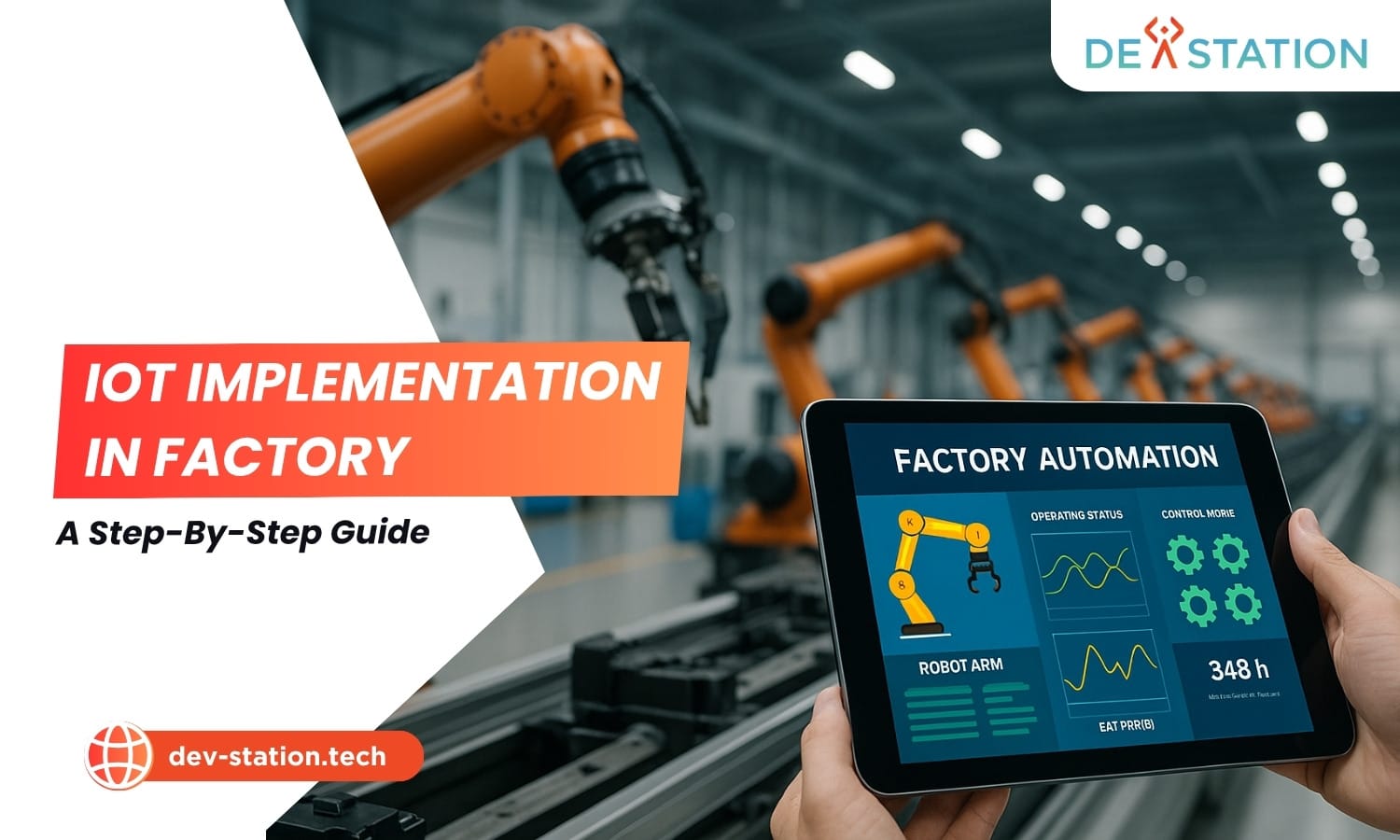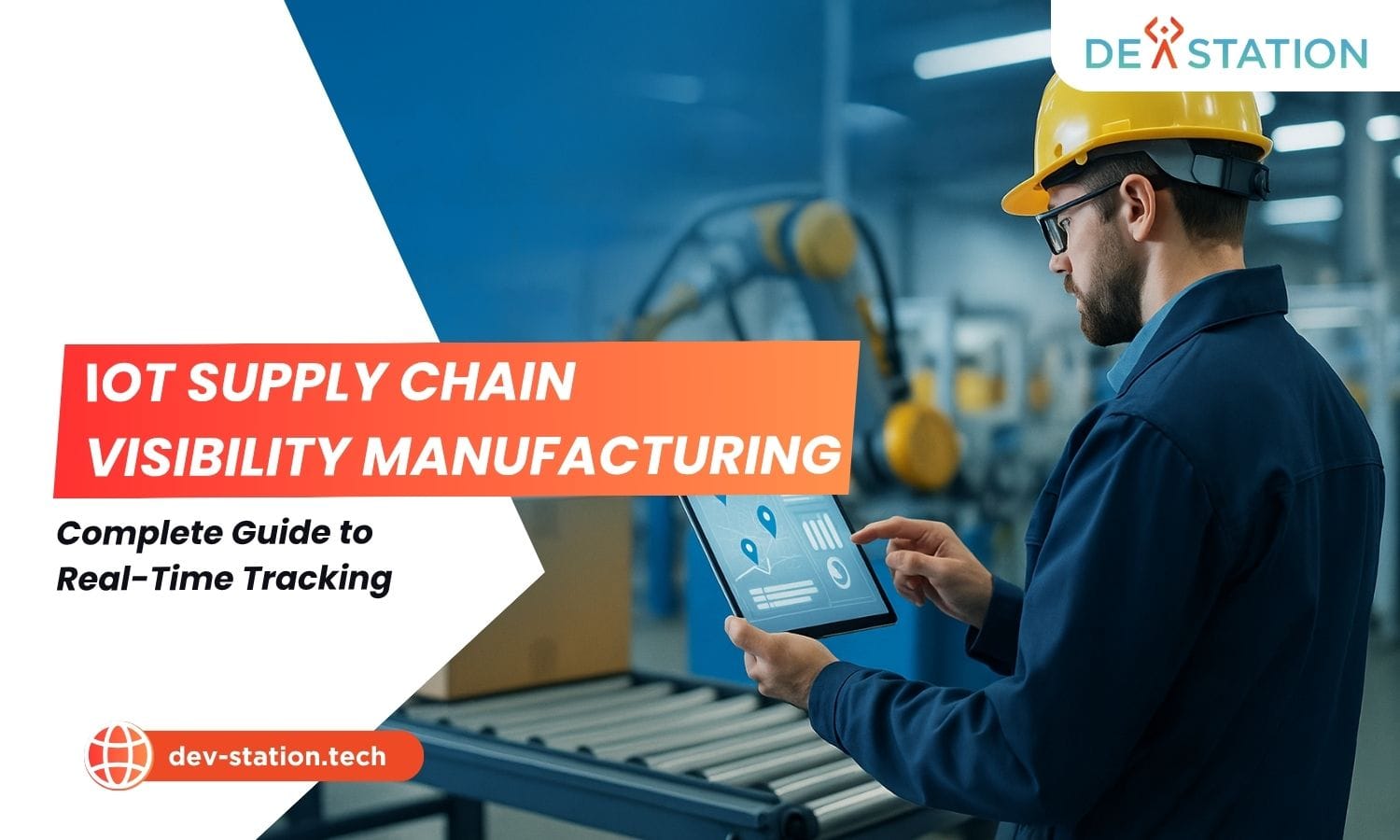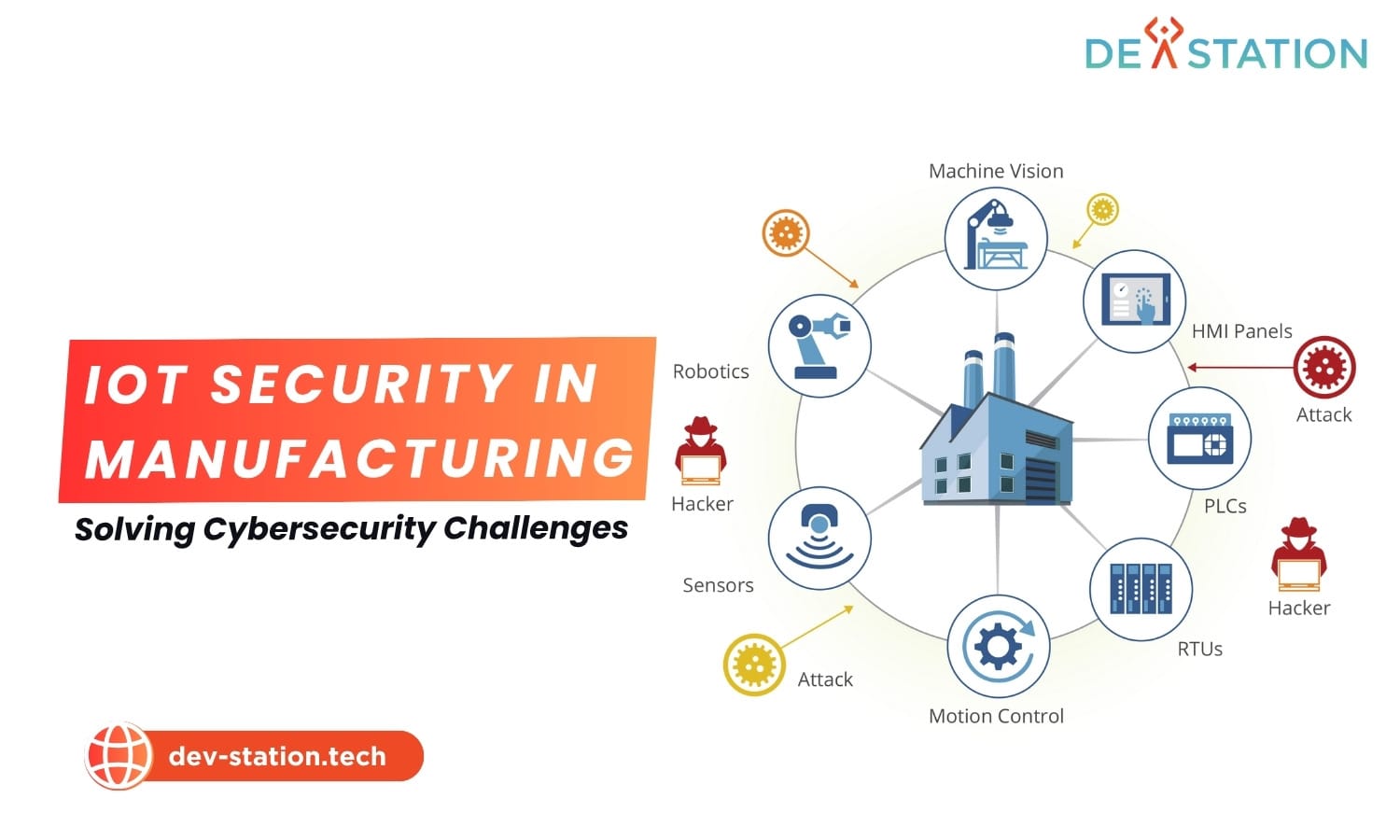An IoT implementation in factory settings, a core component of Industry 4.0, involves integrating connected sensors and smart devices to capture real-time production data for process optimization. At Dev Station Technology, we provide a clear deployment strategy to transform your operations, enhancing efficiency and enabling a data-driven manufacturing setup. This factory digitization plan unlocks predictive insights, improves asset tracking, and boosts overall productivity.
Contents
ToggleHow Do You Implement an IoT Strategy for Your Factory?
A successful IoT implementation follows a structured six-step roadmap: defining clear goals, assembling a cross-functional team, running a targeted pilot project, selecting the right technology, executing a phased full-scale deployment, and establishing a cycle of continuous monitoring and optimization.
Embarking on a smart factory deployment is a transformative journey that requires careful planning and execution. A structured industrial IoT rollout ensures that your investment aligns with business objectives and delivers measurable results. At Dev Station Technology, we have refined this process into a clear, actionable pilot project manufacturing framework that guides you from initial concept to a fully scaled, intelligent production environment.
Step 1: Strategy and Goal Definition
The first step is to define specific, measurable, achievable, relevant, and time-bound (SMART) goals for your IoT initiative. This involves identifying key pain points in your current operations and determining how a connected manufacturing setup can address them.
Before a single sensor is installed, your leadership team must align on the core business drivers. Are you aiming to reduce unplanned downtime, improve Overall Equipment Effectiveness (OEE), enhance quality control, or increase supply chain visibility? Each goal will dictate the type of data you need to collect and the technology you will deploy. For instance, a goal to reduce downtime by 20% within 12 months requires a focus on predictive maintenance sensors on critical machinery. A recent Deloitte survey found that 92% of manufacturers believe smart manufacturing will be the main driver for competitiveness in the coming years, underscoring the importance of a clear strategic vision.
Step 2: Assembling Your Core Team
A successful IoT project requires a cross-functional team that bridges the gap between Information Technology (IT) and Operational Technology (OT). This team should include representatives from operations, engineering, IT, and data analytics.
Your team will be the engine of your digital transformation. An ideal team structure includes an executive sponsor, a project manager, an OT specialist who understands the factory floor, an IT architect to manage network and cloud infrastructure, and a data analyst to interpret the insights. According to a 2025 survey, one of the top challenges in IoT implementation is the lack of in-house expertise. Building this blended team early ensures that both the physical and digital aspects of the project are aligned. For specialized expertise, engaging an iot consulting firm can provide critical guidance.
Step 3: Conducting a Proof of Concept
A Proof of Concept (PoC) is a small-scale pilot project designed to test the feasibility and value of a specific IoT use case in a controlled environment. It validates your assumptions and helps build a business case for a larger investment.
The goal of a PoC is to achieve a quick win. Choose a single, high-impact problem to solve, such as monitoring the temperature of a critical machine to prevent overheating. Define clear success metrics for the PoC, such as accurately predicting a failure 24 hours in advance. Understanding what is a proof of concept is crucial for minimizing risk and demonstrating value to stakeholders before committing significant resources. A successful PoC provides invaluable data and builds momentum for the full-scale project.
Step 4: Selecting Technology and Partners
This step involves choosing the right combination of hardware (sensors, gateways), connectivity (Wi-Fi, 5G, LoRaWAN), and software platforms that align with your goals, budget, and architectural choices.
The technology you choose is foundational to your smart factory. Your selection process should evaluate vendors based on scalability, security, and integration capabilities. Partnering with an experienced iot software development provider can help navigate this complex landscape. The global Industrial IoT market is projected to grow from USD 556.6 billion in 2025 to over USD 1.7 trillion by 2035, demonstrating the rapid pace of innovation. Your technology choices must support your long-term vision for factory automation and data analytics.
Step 5: Full-Scale Deployment and Integration
This is the execution phase where the selected IoT solution is rolled out across the factory floor and integrated with existing enterprise systems like your MES and ERP.
A phased deployment strategy is often the most effective approach. Start with one production line or area and gradually expand. This allows your team to learn and adapt without disrupting the entire operation. Integration is key to unlocking the full value of your IoT data. By connecting your IoT platform to your ERP, for example, you can automate inventory reordering based on real-time production data. A well-documented iot implementation in factory settings prioritizes seamless data flow between OT and IT systems.
Step 6: Ongoing Optimization and Maintenance
An IoT implementation is not a one-time project; it is an ongoing process of monitoring, analyzing, and optimizing. This includes device management, security updates, and refining your analytics models.
Your smart factory should evolve over time. Continuously analyze the data to find new opportunities for improvement. As your system matures, you may identify new use cases or areas for expansion. Establishing a robust plan for iot maintenance and support is critical for long-term reliability and security. This ensures your connected factory remains a valuable asset that adapts to changing business needs.
Why Should Your Factory Adopt an IoT Strategy?
Factories adopt IoT to achieve significant gains in operational efficiency, reduce downtime through predictive maintenance, enhance product quality, and create safer working environments, ultimately driving competitiveness and profitability in the era of Industry 4.0.
The global Industrial IoT (IIoT) market size is projected to exhibit a compound annual growth rate (CAGR) of 24.5% from 2024 to 2032, reaching an estimated USD 673.95 billion. This explosive growth is fueled by tangible business outcomes. Companies that embrace a factory digitization plan are not just keeping up with technology; they are fundamentally reshaping their operations to be more resilient, agile, and data-driven.
What Are the Primary Drivers for Industrial IoT Adoption?
The primary drivers are the pursuit of operational efficiency, the need for predictive maintenance to increase asset uptime, real-time quality control to reduce defects, and enhanced supply chain visibility to improve logistics and inventory management.
IoT applications are proven to increase manufacturing productivity by up to 25%. Let’s look at the key drivers in more detail:
- Predictive Maintenance: Instead of waiting for a machine to fail, IoT sensors can monitor vibrations, temperature, and other indicators to predict a failure before it happens. This can reduce unplanned downtime by up to 28%.
- Operational Efficiency: Real-time production monitoring provides live data on machine performance and operator productivity. This enables managers to identify bottlenecks and optimize workflows, leading to throughput increases of 10-15%.
- Quality Control: AI-powered vision systems and IoT sensors can automatically detect manufacturing defects on the production line with greater accuracy than human inspection, reducing scrap and rework costs.
What Are the Main Challenges of an IoT Implementation?
The top five challenges are high initial implementation costs, cybersecurity risks, integration with legacy systems, managing massive data volumes, and a lack of in-house skills to manage the IoT ecosystem.
While the benefits are compelling, it is important to be aware of the potential hurdles. A successful deployment strategy anticipates and mitigates these issues. The primary 6 challenges of iot include securing the expanded network of connected devices and integrating modern IoT platforms with older, legacy factory equipment (a brownfield deployment). Addressing cybersecurity from day one is non-negotiable, as each connected device represents a potential entry point for threats.
What Is the Right IoT Architecture for Your Factory?
The right architecture depends on your specific needs for latency, bandwidth, security, and cost, often resulting in a hybrid model that combines edge computing for real-time processing with cloud computing for large-scale analytics and storage.
Choosing your technical foundation is one of the most critical decisions in your IoT journey. There is no one-size-fits-all answer; the optimal choice is a balance between processing data locally (on the edge) versus centrally (in the cloud). Understanding the layers of a robust iot architecture is the first step toward making an informed decision.
When Should You Choose an Edge Computing Model?
Edge computing is ideal for applications requiring near-instantaneous response times, such as automated quality control, robotic automation, and worker safety alerts, where sending data to the cloud for analysis would introduce unacceptable latency.
Edge computing processes data locally, at or near the source of data generation. For example, an AI vision system that detects a defect on a high-speed production line must trigger a rejection mechanism in milliseconds. Waiting for that video frame to travel to a cloud server and back is not feasible. Edge computing also reduces data transmission costs and can continue to operate even if the factory’s internet connection is temporarily lost, improving reliability.
How Do You Decide Between On-Premise and Cloud Solutions?
The decision often becomes a hybrid approach. The cloud offers superior scalability, accessibility, and powerful analytics, while on-premise or edge solutions provide the low latency and data control needed for real-time factory floor operations.
A hybrid architecture offers the best of both worlds. Time-sensitive data is processed at the edge, while aggregated data is sent to the cloud for advanced analytics, machine learning model training, and long-term storage. This allows you to gain deep insights from historical data without compromising the real-time performance of your factory operations. Gartner notes that complex IIoT deployments often leverage a hybrid implementation to meet the demands of both OT and IT systems.
| Factor | Edge/On-Premise | Cloud |
|---|---|---|
| Latency | Very Low (milliseconds) | Higher (can be seconds) |
| Data Security | High (data stays on-site) | Robust, but requires secure transmission |
| Scalability | Limited by hardware | Virtually unlimited |
| Cost | High upfront (CapEx) | Subscription-based (OpEx) |
How Do You Evaluate the Success and ROI of Your IoT Implementation?
Success is evaluated by tracking specific Key Performance Indicators (KPIs) tied to your initial goals and calculating the financial Return on Investment (ROI) by comparing the total cost of ownership against the value generated from operational improvements and cost savings.
Measuring the impact of your smart factory initiative is essential for justifying the investment and guiding future optimizations. One barrier to adoption for many managers is the difficulty in illustrating the benefits and project payback period. However, with a clear framework, this process becomes straightforward.
What Key Metrics Should You Use to Measure IoT Success?
Key metrics include Overall Equipment Effectiveness (OEE), Mean Time Between Failures (MTBF), Mean Time To Repair (MTTR), production yield, scrap rate, and energy consumption per unit produced.
These metrics provide a quantitative view of your operational improvements. For example, a successful predictive maintenance program will directly increase your MTBF and reduce unplanned downtime, which in turn boosts your OEE. One case study showed that a beverage manufacturer increased machine availability from 90% to 94% and performance from 87% to 91% after implementing an IoT solution.
How Do You Calculate the Return on Investment for IoT?
The basic ROI formula is: (Financial Gain – Project Cost) / Project Cost. Financial gains include cost savings from reduced downtime, lower energy bills, and decreased material waste, as well as increased revenue from higher throughput.
Calculating a clear return on investment is critical. Let’s consider a detailed example. A mid-sized automotive components manufacturer invested $4.2 million in a smart factory solution. Their gains included:
- A 28% reduction in unplanned downtime.
- A 37% reduction in manufacturing defects.
- A 15% reduction in overall production costs.
These operational improvements allowed them to take on new business that increased annual revenue by $7.5 million, achieving a full return on their investment in under two years. Studies show that deploying Industry 4.0 solutions can generate an operational cost savings ROI of 10x to 20x over five years.
Your digital transformation journey is a marathon, not a sprint. By following a structured IoT roadmap and focusing on measurable outcomes, you can turn your factory into a smart, connected, and highly efficient operation. To explore how these strategies can be tailored to your specific needs, Dev Station Technology is here to help you navigate every step of the process.
For a deeper dive into how a connected factory guide can revolutionize your production, learn more at our website dev-station.tech or contact our team for a personalized consultation at sale@dev-station.tech.




